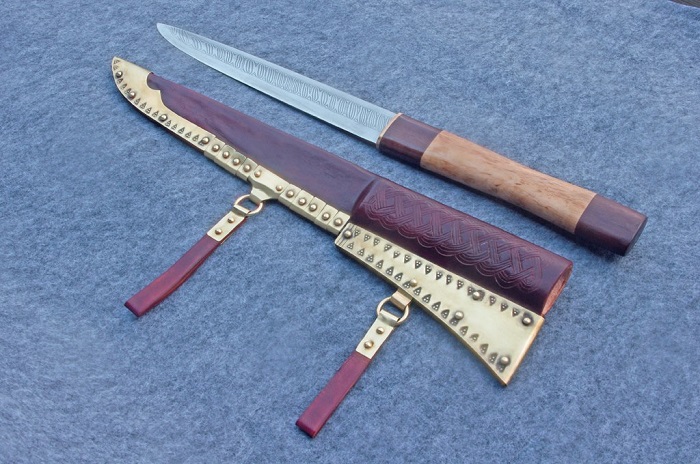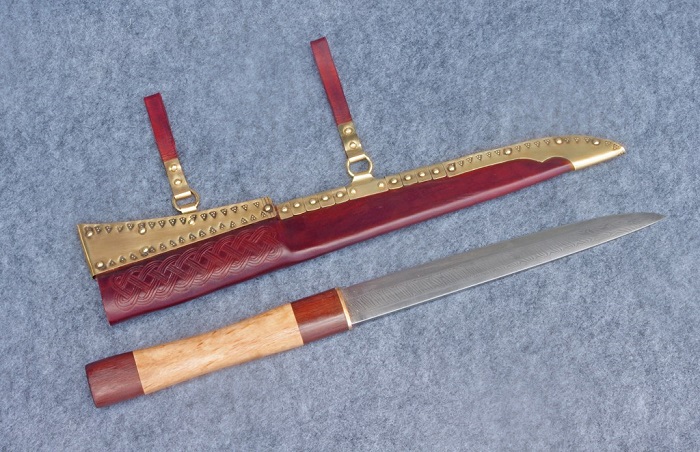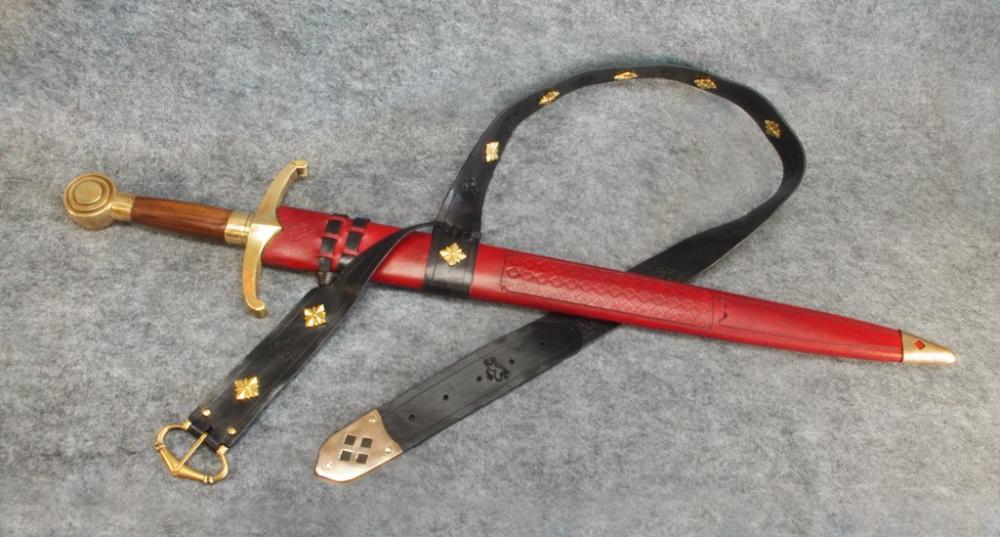
Harry Marinakis
Members-
Posts
123 -
Joined
-
Last visited
Content Type
Profiles
Forums
Events
Blogs
Gallery
Everything posted by Harry Marinakis
-
Acceptable "character" in leather vs unacceptable.
Harry Marinakis replied to artwithapulse's topic in All About Leather
Thanks -
Medieval Sword Scabbard
Harry Marinakis replied to Harry Marinakis's topic in Historical Reenactment
hidden edge-flesh stitch on a butted seam This link has a diagram, they call it the edge-flesh butt joint: https://banneroftripoli.wordpress.com/2015/03/07/shoes-acceptable-styles-and-how-to-make-a-pair/ The flesh side is on the inside, so when you're done you do not see any stitching. -
Medieval Sword Scabbard
Harry Marinakis replied to Harry Marinakis's topic in Historical Reenactment
Seems like a lot of work. Why not just do a hidden edge-flesh stitch on a butted seam, like the Vikings used to use. Here's my latest scabbard -
I bought a large coil spring at the junkyard for about $3. I've been making a lot of punches and stamps, and I've barely used any of the steel. I just cut off, straightened and normalized another 15 inches, and can probably get at least another dozen stamps and punches from this piece of steel. I've been annealing the steel in vermiculite, and then using a Dremel tool to make the design. I use the stamps on both steel and leather, so I harden and temper.
-
Medieval Sword Scabbard
Harry Marinakis replied to Harry Marinakis's topic in Historical Reenactment
-
I feel quite confident in my ability to dye leather. In fact, I often experiment a lot with dye mixes and mix my own custom colors. I use Fiebing's dyes exclusively. Recently I wanted to dye some natural 2-3 oz. veg tan to match another piece of leather that was a medium brown with a hint of green, almost olive. I cut off a piece of the natural 2-3 oz. veg tan that I was going to dye, and experimented with various dye mixes. I mixed up a 4 oz. bottle of dye and started tweaking the color. I settled on a brown/green that was a bit lighter than the other leather, but I planned to add some dark brown antiquing around the edges. My custom color is attached below. After a lot of tooling and preparation, I shook up my bottle of dye (a mix of Fiebing's Russet & Fiebing's Green), diluted it 50:50 with alcohol and dyed the 2-3 oz. leather. It looked pretty dark when the leather was wet - but it stayed dark even once dry. Like dark chocolate. So dark that it looks black from 6 feet away. Okay, what happened?
-
Best Way To Make A Strap End Punch Work On A Small Strap?
Harry Marinakis replied to Gregspitz's topic in How Do I Do That?
Get a small piece of sheet steel and a belt sander and make yourself a hand-cutting guide. -
The problem might be superficial dye that remains on the surface of the leather. I use a damp sponge and wipe down the leather over and over until I don't get any more dye on the sponge. Never had any problem with bleeding or staining of clothes.
-
I run the flesh side on a belt sander (220 grit) until smooth
- 30 replies
-
- flesh side
- burnishing
-
(and 1 more)
Tagged with:
-
Medieval Sword Scabbard
Harry Marinakis replied to Harry Marinakis's topic in Historical Reenactment
-
Medieval Sword Scabbard
Harry Marinakis replied to Harry Marinakis's topic in Historical Reenactment
Stitches used on Medieval scabbards: 1. Butted seam with a running whip stitch (show in the original post) 2. Butted seam with a hidden edge-flesh stitch 3. Closed seam with a saddler's stitch Stitch spacing seemed to be around 3/16" to 1/4" -
Medieval Sword Scabbard
Harry Marinakis replied to Harry Marinakis's topic in Historical Reenactment
The cross stitching shown on the Ye Olde Gaffers page is not historical. Such stitching was not used during medieval periods. -
Medieval Flask
Harry Marinakis replied to Brushpopper's topic in Purses, Wallets, Belts and Miscellaneous Pocket Items
I found this canteen on a civil war reenactment site. -
Medieval Flask
Harry Marinakis replied to Brushpopper's topic in Purses, Wallets, Belts and Miscellaneous Pocket Items
Here is the leather flask that I made, using a stainless-steel canteen and a wooden stopper. It was the very first piece that I ever made. And although it is not very pretty, it looks rather authentic and I never put anything in it except 750 ml of the finest Tequila. Brushpopper, your stitching is immaculate. How do you do it? Even today I cannot achieve anything close to your work. What's your secret? -
Medieval Sword Scabbard
Harry Marinakis replied to Harry Marinakis's topic in Historical Reenactment
Good question I don't use my scabbards very much, haven't drawn my sword in anger in weeks. (: Don't have much information on stitching from the Bronze Age through the Iron Age. There is some erevidence that a few leather covers were glued into place. The whip stitch shown above in my photo was used during the Migration Period all the way through the Medieval Period, but it was not the most common stitch. The early Vikings preferred a hidden edge-flesh stitch with a butted or beveled seam, perhaps out of concern for stitch wear. The later Vikings preferred a closed seam with a saddler's stitch, which was infinitely easier to sew than a hidden stitch, and probably had less wear on the stitches than a whip stitch. A lot of Viking and Medieval finds are leather scabbard covers that had been sliced lengthwise and stripped from the wood core, suggesting that the leather was regularly replaced anyway. For what reason? -
Medieval Sword Scabbard
Harry Marinakis replied to Harry Marinakis's topic in Historical Reenactment
Here are examples. One photo of another one of my scabbards, the other is an image from Medieval illuminated manuscripts showing the same thong belts. Manuscript: Massacre of the Innocents, Germany, c. AD 1350, British Library, London, Shelfmark Add. 17687 B The offset belt pulls the scabbard into an oblique angle so it does not hang vertically, also places the sword's grip forward so that it's easier to find and grasp. The tighter the belt, the more the scabbard is pulled obliquely. -
Trevor, looks like you used the same technique as I did? I sanded the leather very thin Glued a cord down the middle of the trim, folded it over and glued it closed Then I sandwiched the trim between the inner and outer layers and stitched it Trevor's stitching is much cleaner than mine! More of a semi-rolled edge than a true rolled edge.
-
Medieval Flask
Harry Marinakis replied to Brushpopper's topic in Purses, Wallets, Belts and Miscellaneous Pocket Items
I used a stainless-steel canteen and wrapped it in leather, just like yours. Looks just a real, but it can hold hot or cold liquids, -
Medieval sword scabbard This is a historically-accurate reproduction of a scabbard that is depicted on a statue at the Naumburg cathedral, German Empire, circa AD 1200. 1. Carved 2-piece poplar wood core lined with a fullered, woven-wool textile 2. Veg-tan leather cover (2-3 oz) dyed with Fiebing's Medium Brown 3. Oil-tan Latigo leather belt (6-8 oz, sanded down to 3-4 oz.) in a factory drum-dyed cream color 4. Natural linen thread 5. Bronze chape 6. Hide glue Sword is a reproduction of an Oakeshott Type XI sword (made by Del Tin, model 2121)
-
Well... I made a sword scabbard and tried this method to add some piping around the rain guard. But it did not work because there were too many curves and angle changes. So I used an alternate technique that wasn't quite as clean.
-


























